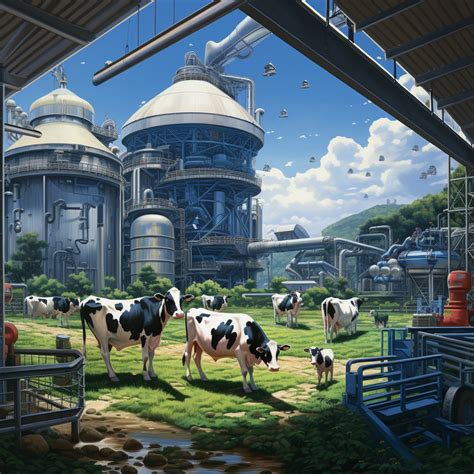Improving Dairy Health: The Cost of AI
The dairy industry is undergoing a significant transformation, driven by the increasing adoption of artificial intelligence (AI). From optimizing feed management to detecting early signs of disease, AI promises to revolutionize dairy farming, boosting productivity and animal welfare. However, integrating AI into dairy operations comes with a considerable cost, encompassing not only the initial investment in technology but also ongoing maintenance, training, and data management. This article explores the various cost components associated with implementing AI in dairy health management and examines the potential return on investment (ROI).
What are the different AI applications in dairy farming?
AI's role in dairy farming is expanding rapidly. Several key applications directly impact dairy health:
- Precision Livestock Farming (PLF): Sensors and AI algorithms analyze data from wearable devices on cows, monitoring their activity, rumination patterns, and even body temperature. This allows for early detection of illnesses like mastitis or lameness, enabling timely intervention and reducing treatment costs.
- Automated Milking Systems: Robotic milking systems use AI to optimize milking schedules and identify individual cow needs, potentially improving milk yield and udder health.
- Feed Management Optimization: AI can analyze data on cow performance, feed composition, and weather conditions to create personalized feeding plans, maximizing milk production and minimizing feed waste.
- Disease Prediction and Prevention: AI models can analyze historical data and real-time sensor information to predict disease outbreaks, allowing farmers to proactively implement preventative measures.
- Reproductive Management: AI can help optimize breeding programs by analyzing reproductive data to predict optimal breeding times and identify potential fertility issues.
What is the upfront cost of implementing AI in dairy health?
The initial investment in AI for dairy health can be substantial and varies widely based on the scale of the operation and the specific technologies adopted. Costs include:
- Hardware: This encompasses the cost of sensors, cameras, wearable devices, robotic milking systems, and other necessary equipment. The price can range from thousands to hundreds of thousands of dollars depending on the complexity and scope of the system.
- Software and AI platforms: Subscription fees for AI software, data analytics platforms, and cloud storage are recurring costs. The cost varies greatly depending on the features and level of support provided.
- Integration costs: Integrating new AI systems into existing farm infrastructure requires specialized expertise and can incur significant costs. This might involve hiring consultants or technicians.
- Training and staff development: Farmers and their staff need training to effectively use and interpret the data generated by AI systems. This can involve workshops, online courses, or on-site training.
What are the ongoing costs of maintaining AI systems in dairy health?
Beyond the initial investment, ongoing costs are crucial to consider:
- Software maintenance and updates: Regular software updates and maintenance are necessary to ensure the accuracy and efficiency of AI systems.
- Data storage and management: Storing and managing large amounts of data generated by AI systems requires robust infrastructure and expertise. This includes cloud storage fees and potentially hiring data scientists or analysts.
- Hardware maintenance and repairs: Sensors, cameras, and other hardware components can malfunction and require repairs or replacement, leading to unexpected costs.
- Technical support: Accessing technical support for troubleshooting issues can be costly.
- Staff salaries: Employing dedicated personnel to manage and monitor AI systems can be a significant expense.
How can I calculate the ROI of AI in dairy health?
Determining the ROI of AI in dairy health requires a careful analysis of both costs and benefits. Key factors to consider include:
- Reduced veterinary costs: Early disease detection can significantly reduce the cost of veterinary care.
- Improved milk yield: Optimized feeding and management practices can lead to increased milk production.
- Reduced labor costs: Automation can reduce the need for manual labor.
- Improved animal welfare: Early disease detection and preventative measures can improve animal health and reduce suffering.
- Increased efficiency: AI can optimize various processes, increasing overall farm efficiency.
Calculating ROI involves comparing the total costs (initial investment and ongoing maintenance) with the total benefits (increased revenue, reduced costs, improved animal welfare). This calculation requires careful data collection and analysis to accurately quantify the impact of AI on the dairy farm's profitability.
Are there any grants or subsidies available to offset the cost of AI in dairy farming?
Government agencies and private organizations often offer grants and subsidies to support the adoption of new technologies in agriculture, including AI. Farmers should research available funding opportunities specific to their region and type of operation. These programs can significantly reduce the financial burden of implementing AI.
What are the future trends in AI for dairy health?
The future of AI in dairy health looks bright. Expect further advancements in:
- More sophisticated AI algorithms: Improving the accuracy and reliability of AI predictions.
- Integration with other technologies: Combining AI with other technologies like the Internet of Things (IoT) and blockchain for enhanced data management and traceability.
- Increased accessibility: Making AI technologies more affordable and user-friendly for smaller dairy farms.
- Focus on sustainability: Utilizing AI to improve resource efficiency and reduce the environmental impact of dairy farming.
Implementing AI in dairy health offers substantial potential benefits, but the costs involved must be carefully considered. A thorough cost-benefit analysis, coupled with exploring available funding opportunities, will help farmers make informed decisions about integrating this transformative technology into their operations. The future of dairy farming is undeniably intertwined with AI, and embracing its potential while managing the associated costs is key to achieving long-term success and sustainability.

